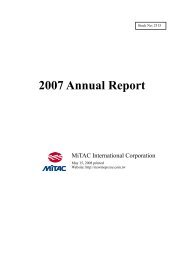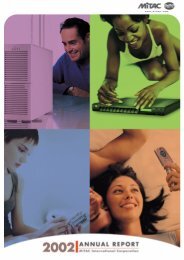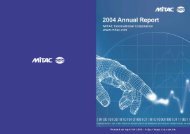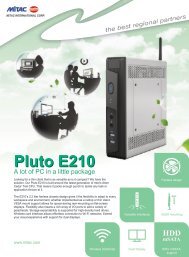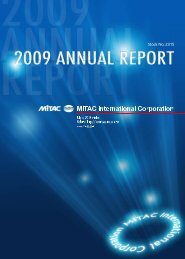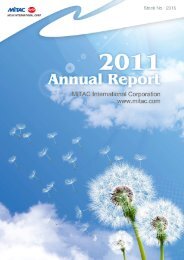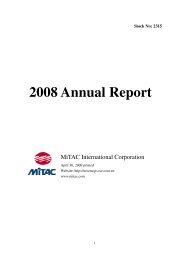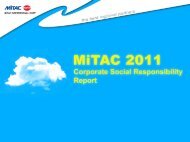Contents - MiTAC
Contents - MiTAC
Contents - MiTAC
Create successful ePaper yourself
Turn your PDF publications into a flip-book with our unique Google optimized e-Paper software.
17) Treasury stock<br />
A. Treasury stock is stated at cost using the weighted average method and is<br />
reported as a deduction under stockholders’ equity.<br />
B. When treasury stock is disposed of, the related gain is credited to “capital<br />
reserve-treasury stock transaction” and any loss is offset against this capital<br />
reserve account. However, when the balance of this capital reserve account is<br />
insufficient to offset the loss, then the remaining amount should be charged<br />
against retained earnings.<br />
C. When treasury stock is retired, the treasury stock account is credited and all<br />
capital account balance related to the treasury shares, including capital reserve<br />
from paid-in capital in excess of par are debited on a proportionate basis. When<br />
the book value of treasury stock is higher than capital account balance,<br />
including additional paid-in capital in excess of par, the difference is debited to<br />
offset against this capital reserve from treasury stock. However, when the<br />
balance of this capital reserve account is insufficient to offset the difference,<br />
then the remaining amount should be charged against retained earnings. When<br />
the book value of treasury stock is less than the capital account balance,<br />
including additional paid-in capital in excess of par, the difference is credited to<br />
capital reserve from treasury stock.<br />
D. Effective January 1, 2003, the Company’s stock traded by subsidiaries was<br />
accounted for as treasury stock when preparing financial statements, and the<br />
disclosure of pro forma information for treating the treasury stocks described<br />
above as an investment is also enclosed in the income statement.<br />
18) Use of Estimates<br />
The preparation of financial statements in conformity with generally accepted<br />
accounting principles requires management to make estimates and assumptions that<br />
affect the reported amounts of assets and liabilities and disclosure of contingent<br />
assets and liabilities at the date of the financial statements, and reported amounts of<br />
revenues and expenses during the reported period. Actual results could differ from<br />
those estimates.<br />
3. EFFECT OF CHANGE IN ACCOUNTING PRINCIPLES<br />
1) Prior to January 1, 2001, the Company’s stocks traded by subsidiaries was recorded as<br />
investments. Effective January 1, 2002, pursuant to the regulations of R.O.C. Securities<br />
and Futures Commission (“SFC”) and Financial Accounting Standard (“SFAS”) No. 30,<br />
“Accounting Standard for Treasury Stock,” the Company’s stock traded by subsidiaries<br />
should be recorded as treasury stock, and no gain or loss can be recognized in profit and<br />
loss accounts. As a result of this change of accounting principle, long-term investment<br />
decreased $328,241, treasury stock increased $246,094, capital reserve-treasury stock<br />
transaction increased $1,019 as of December 31, 2002 and net income decreased<br />
$82,966 for the year ended December 31, 2002.<br />
2) Effective January 2002, the Company adopted revised R.O.C. SFAS No.24, “Earnings<br />
per share” under which the calculation of diluted earnings per share is changed. The<br />
change in accounting principle did not have any impact on the assets and liabilities as of<br />
December 31, 2002 or on the profit and loss for the year ended December 31, 2002.<br />
- 55 -



